247 scholarly books by University Press of New England and 12
have author last names that start with R
247 scholarly books by University Press of New England and 12
247 scholarly books by University Press of New England
12 have author last names that start with R have author last names that start with R
12 have author last names that start with R have author last names that start with R

Confession of a Serial Killer
The Untold Story of Dennis Rader, the BTK Killer
Katherine Ramsland
University Press of New England, 2017
In 1974, Dennis Lynn Rader stalked and murdered a family of four in Wichita, Kansas. Since adolescence, he had read about serial killers and imagined becoming one. Soon after killing the family, he murdered a young woman and then another, until he had ten victims. He named himself “B.T.K.” (bind, torture, kill) and wrote notes that terrorized the city. He remained on the loose for thirty years. No one who knew him guessed his dark secret. He nearly got away with his crimes, but in 2004, he began to play risky games with the police. He made a mistake. When he was arrested, Rader’s family, friends, and coworkers were shocked to discover that B.T.K. had been among them, going to work, raising his children, and acting normal. This case stands out both for the brutal treatment of victims and for the ordinary public face that Rader, a church council president, had shown to the outside world. Through jailhouse visits, telephone calls, and written correspondence, Katherine Ramsland worked with Rader himself to analyze the layers of his psyche. Using his drawings, letters, interviews, and Rader’s unique codes, she presents in meticulous detail the childhood roots and development of one man’s motivation to stalk, torture, and kill. She reveals aspects of the dark motivations of this most famous of living serial killers that have never before been revealed. In this book Katherine Ramsland presents an intelligent, original, and rare glimpse into the making of a serial killer and the potential darkness that lives next door.
[more]
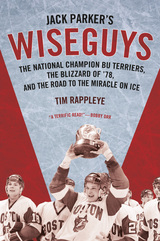
Jack Parker's Wiseguys
The National Champion BU Terriers, the Blizzard of ’78, and the Road to the Miracle on Ice
Tim Rappleye
University Press of New England, 2017
Over the winter of 1977–78, anyone within shouting distance of a two-mile stretch of Boston’s Commonwealth Avenue—from Fenway Park to the trolley curve at Packard’s Corner—found themselves pulled into the orbit of college hockey. The hottest ticket in a sports-mad city was Boston University’s Terriers, a team so tough it was said they didn’t have fans—they took hostages. Eschewing the usual recruiting pools in Canada, Jack Parker and his coaching staff assembled a squad that included three stars from nearby Charlestown, then known as the “armed robbery capital of America.” Jack Parker’s Wiseguys is the story of a high-flying, headline-dominating, national championship squad led by three future stars of the Miracle on Ice, the medal-round game the 1980 U.S. Olympic hockey team won against the heavily favored Soviet Union. Now retired, Parker is a thoughtful statesman for the sport, a revered figure who held the longest tenure of any coach in Boston sports history. But during the 1977–78 season, he was just five years into his reign—and only a decade or so older than his players. Fiery, mercurial, as tough as any of his tough guys, Parker and his team were to face the pressure-cooker expectations of four previous also-ran seasons, further heightened by barroom brawls, off-the-ice shenanigans, and the citywide shutdown caused by one of the biggest blizzards to ever hit the Northeast. This season was to be Parker’s watershed, a roller-coaster ride of nail-biting victories and unimaginable tragedy, played out in increasingly strident headlines as his team opened the season with an unprecedented twenty-one straight wins. Only the second loss of the year eliminated the Terriers from their league playoffs and possibly from national contention; hours after the game Parker’s wife died from cancer. The story of how the team responded—coming back to win the national championship a week after Parker buried his wife—makes a compelling tale for Boston sports fans and everyone else who feels a thrill of pride at America’s unlikely win over the Soviet national team—a victory forged on Commonwealth Avenue in that bitter, beautiful winter of ’78.
[more]
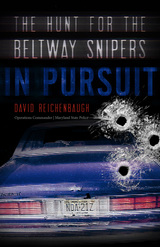
In Pursuit
The Hunt for the Beltway Snipers
David Reichenbaugh
University Press of New England, 2018
October 2, 2002. A bullet pierced the window of a crafts store in Maryland, just missing the cashier. But other bullets hit their targets. In Pursuit follows the hunt for the Beltway snipers during the twenty-three-day shooting spree that terrorized Maryland, Virginia, and the District of Columbia. David Reichenbaugh—the criminal intelligence operations commander for the Maryland State Police, and commanding officer at the scene during the snipers’ capture in Myersville, Maryland—played a major role in the investigation from the first day of the killing spree through its final act, as the snipers were cornered in a rest area in western Maryland. He is one of very few people who know the complete details of the investigation and capture of the snipers. Working against the clock with few clues and little evidence, hundreds of investigators from federal, state, county, and city law enforcement agencies struggled to find answers to the questions: Who were the killers? Was their choice of victims random? And most of all, Why did they kill? When the killers began leaving notes to taunt the police, investigators were finally able to begin assembling a picture, piercing the fog of uncertainty and terror that filled the region.
[more]
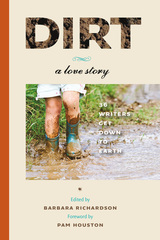
Dirt
A Love Story
Barbara Richardson
University Press of New England, 2015
Community farms. Mud spas. Mineral paints. Nematodes. The world is waking up to the beauty and mystery of dirt. This anthology celebrates the Earth’s generous crust, bringing together essays by award-winning scientists, authors, artists, and dirt lovers to tell dirt’s exuberant tales. Geographically broad and topically diverse, these essays reveal life as lived by dirt fanatics—admiring the first worm of spring, taking a childhood twirl across a dusty Kansas farm, calculating how soil breathes, or baking mud pies. Essayists build a dirt house, center a marriage around dirt, sink down into marshy heaven, and learn to read dirt’s own language. Scientists usher us deep underground with the worms and mycorrhizae to explore the vast and largely ignored natural processes occurring beneath our feet. Whether taking a trek to Venezuela to touch the oldest dirt in the world or reveling in the blessings of our own native soils, these muscular essays answer the important question: How do you get down with dirt? A literary homage to dirt and its significance in our lives, this book will interest hikers, gardeners, teachers, urbanites, farmers, environmentalists, ecologists, and others intrigued by our planet’s alluring skin. Essayists include Vandana Shiva, Peter Heller, Janisse Ray, Bernd Heinrich, Linda Hogan, Wes Jackson, BK Loren, David Montgomery, Laura Pritchett, and Deborah Koons Garcia.
[more]
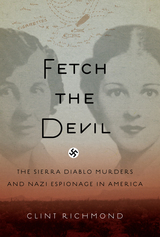
Fetch the Devil
The Sierra Diablo Murders and Nazi Espionage in America
Clint Richmond
University Press of New England, 2014
In 1938, Hazel Frome, the wife of a powerful executive at Atlas Powder Company, a San Francisco explosives manufacturer, set out on a cross-country motor trip with her twenty-three-year-old daughter, Nancy. When their car broke down in El Paso, Texas, they made the most of being stranded by staying at a posh hotel and crossing the border to Juarez for shopping, dining, and drinking. A week later, their near-nude bodies were found in the Chihuahuan Desert. Though they had been seen on occasion with two mystery men, there were no clues as to why they had apparently been abducted, tortured for days, and shot execution style. El Paso sheriff Chris Fox, a lawman right out of central casting, engaged in a turf war with the Texas Rangers and local officials that hampered the investigation. But the victims’ detours had placed them in the path of a Nazi spy ring operating from the West Coast to Latin America through a deep-cover portal at El Paso. The sleeper cell was run by spymasters at the German consulate in San Francisco. In 1938, only the inner circle of the Roosevelt White House and a few FBI agents were aware of the extent to which German agents had infiltrated American industry. Fetch the Devil is the first narrative account of this still officially unsolved case. Based on long forgotten archives and recently declassified FBI files, Richmond paints a convincing portrait of a sheriff’s dogged investigation into a baffling murder, the international spy ring that orchestrated it, and America on the brink of another world war.
[more]
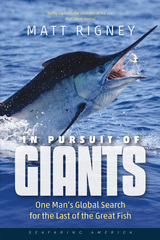
In Pursuit of Giants
One Man's Global Search for the Last of the Great Fish
Matt Rigney
University Press of New England, 2017
For millennia the great fish—marlin, bluefin tuna, and swordfish—have reigned over the world’s oceans and awed human beings. Naturalists, photographers, sportfishermen, and writers from Zane Grey to Ernest Hemingway have been inspired by their beauty, power, and sheer size. But like much other marine life today, these fish face perilous reductions in their populations due to destructive and illegal fishing, inept fisheries management practices, and dramatic changes in ocean ecology, including those wrought by climate change. In Pursuit of Giants is a moving elegy and a call to arms for the protection of these creatures, as well as a five-year, 75,000-mile global adventure story that takes author Matt Rigney on a quest to discover how once-thriving species are now threatened. Rigney’s pilgrimage to encounter these giants takes him from the sportfishing mecca of Cabo San Lucas, to the Great Barrier Reef, from New Zealand to Nova Scotia, Japan and the Mediterranean, as he joins commercial and sport fishermen, marine biologists, fish-farming pioneers, and ocean activists to investigate the dangers these species face, and the various efforts being made—or not—to protect them.
[more]

Disability and the Media
Prescriptions for Change
Charles A. Riley
University Press of New England, 2005
In the past decade, the mass media discovered disability. Spurred by the box-office appeal of superstars such as the late Christopher Reeve, Michael J. Fox, Stephen Hawking, and others, and given momentum by the success of Oscar-winning movies, popular television shows, best-selling books, and profitable websites, major media corporations have reversed their earlier course of hiding disability, bringing it instead to center stage. Yet depictions of disability have remained largely unchanged since the 1920s. Focusing almost exclusively on the medical aspect of injury or illness, the disability profile in fact and fiction leads inevitably to an inspiring moment of “overcoming.” According to Riley, this cliché plays well with a general audience, but such narratives, driven by prejudice and pity, highlight the importance of “fixing” the disability and rendering the “sufferer” as normal as possible. These stories are deeply offensive to persons with disabilities. Equally important, misguided coverage has adverse effects on crucial aspects of public policy, such as employment, social services, and health care. Powerful and influential, the media is complicit in this distortion of disability issues that has proven to be a factor in the economic and social repression of one in five Americans. Newspapers and magazines continue to consign disability stories to the “back of the book” health or human-interest sections, using offensive language that has long been proscribed by activists. Filmmakers compound the problem by featuring angry misfits or poignant heroes of melodramas that pair love and redemption. Publishers churn out self-help titles and memoirs that milk the disability theme for pathos. As Riley points out, all branches of the media are guilty of the same crude distillation of the story to serve their own, usually fiscal, ends. Riley’s lively inside investigation illuminates the extent of the problem while pinpointing how writers, editors, directors, producers, filmmakers, advertisers and the executives who give their marching orders go wrong, or occasionally get it right. Through a close analysis of the technical means of representation, in conjunction with the commentary of leading voices in the disability community, Riley guides future coverage to a more fair and accurate way of putting the disability story on screen or paper. He argues that with the “discovery” by Madison Avenue that the disabled community is a major consumer niche, the economic rationale for more sophisticated coverage is at hand. It is time, says Riley, to cut through the accumulated stereotypes and find an adequate vocabulary that will finally represent the disability community in all its vibrant and fascinating diversity.
[more]
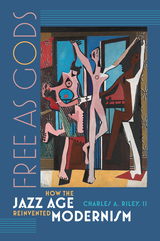
Free as Gods
How the Jazz Age Reinvented Modernism
Charles A. Riley
University Press of New England, 2017
Among many art, music and literature lovers, particularly devotees of modernism, the expatriate community in France during the Jazz Age represents a remarkable convergence of genius in one place and period—one of the most glorious in history. Drawn by the presence of such avant-garde figures as Joyce and Picasso, artists and writers fled the Prohibition in the United States and revolution in Russia to head for the free-wheeling scene in Paris, where they made contact with rivals, collaborators, and a sophisticated audience of collectors and patrons. The outpouring of boundary-pushing novels, paintings, ballets, music, and design was so profuse that it belies the brevity of the era (1918–1929). Drawing on unpublished albums, drawings, paintings, and manuscripts, Charles A. Riley offers a fresh examination of both canonic and overlooked writers and artists and their works, by revealing them in conversation with one another. He illuminates social interconnections and artistic collaborations among the most famous—Fitzgerald, Hemingway, Gershwin, Diaghilev, and Picasso—and goes a step further, setting their work alongside that of African Americans such as Sidney Bechet, Archibald Motley Jr., and Langston Hughes, and women such as Gertrude Stein and Nancy Cunard. Riley’s biographical and interpretive celebration of the many masterpieces of this remarkable group shows how the creative community of postwar Paris supported astounding experiments in content and form that still resonate today.
[more]
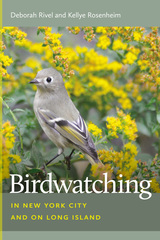
Birdwatching in New York City and on Long Island
Deborah Rivel
University Press of New England, 2016
This easy-to-use guide gives seasonal information for both popular birding sites and those off the beaten path. Precise directions to the best viewing locations within the region’s diverse habitats enable birdwatchers to efficiently explore urban and wild birding hotspots. Over 500 species of birds can be seen in New York City’s five boroughs and on Long Island, one of the most densely populated and urbanized regions in North America, which also happens to be situated directly on the Atlantic Flyway. In this fragmented environment of scarce resources, birds concentrate on what’s available. This means that high numbers of birds are found in small spaces. In fact, Central Park alone attracts over 225 species of birds, which birders from around the world flock to see during spring and fall migration. Beyond Central Park, the five boroughs and Long Island have numerous wildlife refuges of extraordinary scenic beauty where resident and migratory birds inhabit forests, wetlands, grasslands, and beaches. These special places present an opportunity to see a wide array of songbirds, endangered nesting shorebirds, raptors, and an unprecedented number and variety of waterfowl. Including the latest information on the seasonal status and distribution of more than 400 species, with 39 maps and over 50 photographs, this full-color guide features information essential to planning a birding visit. It will become the go-to book for both the region’s longtime birders and those exploring the area for the first time.
[more]

Sergei Prokofiev
A Biography
Robinson
University Press of New England, 2002

Summer Light
Roxana Robinson
University Press of New England, 1995
Roxana Robinson's great gift for the telling detail and strong sense of the emotional shoals lurking just beneath even the calmest surface have inspired comparisons to literary greats like John Cheever, Henry James, and Edith Wharton. In her first novel, we meet Laura, a 29-year-old wife, mother, sister, friend, lover, and erstwhile photographer whose life is painfully out of focus. A month's vacation on the Maine coast with her son, her lover, Ward, and her sister's family is supposed to be an idyllic period of sustenance and calm, but for Laura, who believes that "entropy governed the world, the universe, and the dinner hour," it turns into the ultimate test of her ability to trust herself and others. With trademark intensity and a deft touch for character and place, Robinson creates a perceptive, believable, and gently humorous portrait of an individual "waiting for something that would set her life in order." Laura is as much a study of light and shadow as the photographs she takes. Beautiful but insecure, talented but unwilling to take risks, loved but unable to make a commitment, she is paralyzed by fear and locked into a stasis that Ward is no longer willing to accept. "You don't dare take a stand on anything," he tells her. “You're so terrified of failure you don't dare do anything.” When her estranged husband arrives for a weekend visit, however, the emotional collision rocks Laura's inaction, causing a tiny shake of the kaleidoscope that creates a vastly different pattern. The image is razor sharp at last: "As though she were changing lenses, as though she had suddenly discovered another light source," she sees that her life is her own. That new understanding empowers her to make a symbolic -- and a literal -- leap of faith that saves her own life and the lives of those she loves.
[more]
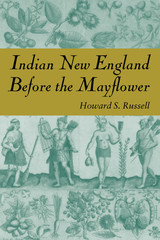
Indian New England Before the Mayflower
Howard S. Russell
University Press of New England, 1983
In offering here a highly readable yet comprehensive description of New England's Indians as they lived when European settlers first met them, the author provides a well-rounded picture of the natives as neither savages nor heroes, but fellow human beings existing at a particular time and in a particular environment. He dispels once and for all the common notion of native New England as peopled by a handful of savages wandering in a trackless wilderness. In sketching the picture the author has had help from such early explorers as Verrazano, Champlain, John Smith, and a score of literate sailors; Pilgrims and Puritans; settlers, travelers, military men, and missionaries. A surprising number of these took time and trouble to write about the new land and the characteristics and way of life of its native people. A second major background source has been the patient investigations of modern archaeologists and scientists, whose several enthusiastic organizations sponsor physical excavations and publications that continually add to our perception of prehistoric men and women, their habits, and their environment. This account of the earlier New Englanders, of their land and how they lived in it and treated it; their customs, food, life, means of livelihood, and philosophy of life will be of interest to all general audiences concerned with the history of Native Americans and of New England.
[more]
READERS
Browse our collection.
PUBLISHERS
See BiblioVault's publisher services.
STUDENT SERVICES
Files for college accessibility offices.
UChicago Accessibility Resources
home | accessibility | search | about | contact us
BiblioVault ® 2001 - 2024
The University of Chicago Press









